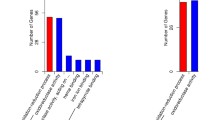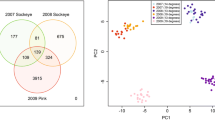Abstract
To characterize thermal-responsive genes in fish, firstly, juvenile rainbow trout were reared in four different temperature conditions (average temperatures were 10, 14, 18, and 22 °C, respectively) and differentially expressed genes were identified. Gene expression in the liver was analyzed by the differential display method, followed by validation using real-time PCR. Subsequently, to examine whether the identified genes show heritable differences, the gene expression levels were compared among juveniles of three genetically distinct lines of rainbow trout (a strain and two closed colonies) by rearing at two different temperature conditions (average 14 and 22 °C). By rearing at 22 °C, growth retardation was observed compared with fish reared at 14 and 18 °C, and six genes were identified as differentially expressed genes in response to the rearing temperature in the gene expression analyses. With the increase in rearing temperature, gene expressions of a complement C1q and two ribosomal proteins were significantly up-regulated. On the other hand, three metabolic genes (betaine homocysteine methyltransferase, triosephosphate isomerase, and glucose-6-phosphatase) were down-regulated, indicating a metabolic depression due to high temperature. In the subsequent analyses, in response to the rearing temperature (14 and 22 °C), there was a trend that the complement C1q and glucose-6-phosphatase genes showed different expression patterns among the three rainbow trout lines, suggesting heritable differences in these genes. Our study provides information on thermal-responsive genes in fish, and we anticipate it will facilitate further investigation in the thermal biology of fish.



Similar content being viewed by others
References
Ahmad SM, Shah FA, Bhat FA, Bhat JIA, Balkhi MH (2011) Thermal adaptability and disease association in common carp (Cyprinus carpio communis) acclimated to different (four) temperatures. J Ther Biol 36:492–497
Aida K, Sakai K, Nomura M, Lou SW, Hanyu I, Tanaka M, Tazaki S, Ohto H (1984) Reproductive activity of a twice-annually spawning strain of rainbow trout. Bull Jap Soc Sci Fish 50:1165–1172
Anttila K, Dhillon RS, Boulding EG, Farrell AP, Glebe BD, Elliott JAK, Wolters WR, Schulte PM (2013) Variation in temperature tolerance among families of Atlantic salmon (Salmo salar) is associated with hypoxia tolerance, ventricle size and myoglobin level. J Exp Biol 216:1183–1190
Barton BA (1996) General biology of salmonids. In: Pennell W, Barton BA (eds) Principles of Salmonid Aquaculture. Elsevier, Amsterdam, pp 22–95
Binner M, Kloas W, Hardewig I (2008) Energy allocation in juvenile roach and burbot under different temperature and feeding regimes. Fish Physiol Biochem 34:103–116
Castilho PC, Buckley BA, Somero G, Block BA (2009) Heterologous hybridization to a complementary DNA microarray reveals the effect of thermal acclimation in the endothermic bluefin tuna (Thunnus orientalis). Mol Ecol 18:2092–2102
Chomczynski P, Sacchi N (1987) Single-step method of RNA isolation by acid guanidinium thiocyanate-phenol-chloroform extraction. Anal Biochem 162:156–159
Deane EE, Woo NY (2011) Advances and perspectives on the regulation and expression of piscine heat shock proteins. Rev Fish Biol Fish 21:153–185
Handeland SO, Imsland AK, Stefansson SO (2008) The effect of temperature and fish size on growth, feed conversion efficiency and stomach evaculation rate of Atlantic salmon post-smolts. Aquaculture 283:36–42
Healy TM, Tymchuk WE, Osborne EJ, Schulte PM (2010) Heat shock response of killifish (Fundulus heteroclitus): candidate gene and heterologous microarray approaches. Physiol Genomics 41:171–184
Heredia-Middleton P, Brunelli J, Drew RE, Thorgaard GH (2008) Heat shock protein (HSP70) RNA expression differs among rainbow trout (Oncorhynchus mykiss) clonal lines. Comp Biochem Physiol B 149:552–556
Holker F (2003) The metabolic rate of roach in relation to body size and temperature. J Fish Biol 62:565–579
Ikeguchi K, Ineno T, Itoi S, Kondo H, Kinoshita S, Watabe S (2006) Increased levels of mitochondrial gene transcripts in the thermally selected rainbow trout (Oncorhynchus mykiss) strain during embryonic development. Mar Biotechnol 8:178–188
Kassahn KS, Crozier RH, Pörtner HO, Caley MJ (2009) Animal performance and stress: responses and tolerance limits at different levels of biological organization. Biol Rev 84:277–292
Kayhan FE, Duman BS (2010) Heat shock protein genes in fish. Turk J Fish Aquat Sci 10:287–293
Koc EC, Burkhart W, Blackburn K, Moyer MB, Schlatzer DM, Moseley A, Speremulli LL (2001) The large subunit of the mammalian mitochondrial ribosome. J Biol Chem 276:43958–43969
Kullgren A, Jutfelt F, Fontanillas R, Sundell K, Samuelsson L, Wiklander K, Kling P, Koppe W, Larsson DGJ, Bjornsson BT, Jonsson E (2013) The impact of temperature on the metabolome and endocrine metabolic signals in Atlantic salmon (Salmo salar). Comp Biochem Physiol A 164:44–53
Lewis JM, Hori TS, Rise ML, Walsh PJ, Currie S (2010) Transcriptome responses to heat stress in the nucleated red blood cells of the rainbow trout (Oncorhynchus mykiss). Physiol Genomics 42:361–373
Masaoka T, Mutou K, Oda S, Iwata M (1997) Origin and characteristics in the salmonid pedigree extending species at Nikko branch, National Research Institute of Aquaculture. Youshokuken Siryou 14: ISSN 0915-6100 (in Japanese)
Molony BW, Church AR, Maguire GB (2004) A comparison of the heat tolerance and growth of a selected and non-selected line of rainbow trout, Oncorhynchus mykiss, in Western Australia. Aquaculture 241:655–665
Nayak A, Pednekar L, Reid KBM, Kishore U (2011) Complement and non-complement activating functions of C1q: a prototypical innate immune molecules. Innate Immun 18:350–363
Nordlie RC, Foster JD, Lange AJ (1999) Regulation of glucose production by the liver. Annu Rev Nutr 19:379–406
Ohlendieck K (2010) Proteomics of skeletal muscle glycolysis. Biochim Biophys Acta 1804:2089–2101
Oku H, Koizumi N, Okumura T, Kobayashi T, Umino T (2006) Molecular characterization of lipoprotein lipase, hepatic lipase and pancreatic lipase: effects of fasting and refeeding on their gene expression in red sea bream Pagrus major. Comp Biochem Physiol B 145:168–178
Pajares MA, Perez-Sala D (2006) Betain homocysteine S-methyltransferase: just a regulator of homocysteine metabolism? Cell Mol Life Sci 63:2792–2803
Perry GML, Ferguson MM, Sakamoto T, Danzmann RG (2005) Sex-linked quantitative trait loci for thermotolerance and length in the rainbow trout. J Heredity 96:97–107
Quinn NL, McGowan CR, Cooper GA, Koop B, Davidson WS (2011) Identification of genes associated with heat tolerance in Arctic charr exposed to acute thermal stress. Physiol Genomics 43:685–696
Ramakrishnan V, Davies C, Gerchman SE, Golden BL, Hoffmann DW, Jaishree TN, Kycia JH, Porter S, White SW (1995) Structures of prokaryotic ribosomal proteins: implications for RNA binding and evolution. Biochem Cell Biol 73:979–986
Rebl A, Verleih M, Kobis JM, Kuhn C, Wimmers K, Kollner B, Goldammer T (2013) Transcriptional profiling of gill tissue in regionally bred and globally farmed rainbow trout strains reveals different strategies for coping with thermal stress. Mar Biotechnol 15:445–460
Richards RC, Short CE, Driedzic WR, Ewart KV (2010) Seasonal changes in hepatic gene expression reveal modulation of multiple process in rainbow smelt (Osmerus mordax). Mar Biotechnol 12:650–663
Roberts RJ, Agius C, Saliba C, Bossier P, Sung YY (2010) Heat shock proteins (chaperones) in fish and shellfish and their potential role in relation to fish health: a review. J Fish Disease 33:789–801
Sarma JV, Ward PA (2011) The complement system. Cell Tissue Res 343:227–235
Sonna LA, Fujita J, Gaffin SL, Lilly CM (2002) Molecular biology of thermoregulation, invited review: effects of heat and cold stress on mammalian gene expression. J Appl Physiol 92:1725–1742
Stein M, Gabdoulline RR, Wade RC (2010) Cross-species analysis of the glycolytic pathway by comparison of molecular interaction fields. Mol BioSyst 6:162–174
Vergauwen L, Knapen D, Hagenaars A, Boeck GD, Blust R (2013) Assessing the impact of thermal acclimation on physiological condition in the zebrafish model. J Comp Physiol B 183:109–121
Viant MR, Werner I, Rosenblum ES, Gantner AS, Tjeerdema RS, Johnson ML (2003) Correlation between heat-shock protein induction and reduced metabolic condition in juvenile steelhead trout (Oncorhynchus mykiss) chronically exposed to elevated temperature. Fish Physiol Biochem 29:159–171
Vornanen M, Hassinen M, Koskinen H, Krasnov A (2005) Steady-state effects of temperature acclimation on the transcriptome of the rainbow trout. Am J Physiol Regul Integr Comp Physiol 289:1177–1184
Acknowledgments
We would like to thank Mr. Kouji Mutou and Mr. Hidefumi Nakamura (Nikko Station, Natl. Res. Inst. Aquaculture) for their helpful assistance and maintenance of fish. We also would like to thank Mr. Hiroaki Uchida (Nagisa Aquarium, Yamaguchi, Japan) for his kind help with the feeding experiments. Additionally, we appreciate the helpful comments of anonymous reviewers of this report. This work was financially supported by the Ministry of Agriculture, Forestry and Fisheries, Japan, through a research project entitled “Development of technologies for mitigation and adaptation to climate change in Agriculture, Forestry and Fisheries.”
Author information
Authors and Affiliations
Corresponding author
Rights and permissions
About this article
Cite this article
Oku, H., Tokuda, M., Matsunari, H. et al. Characterization of differentially expressed genes in liver in response to the rearing temperature of rainbow trout Oncorhynchus mykiss and their heritable differences. Fish Physiol Biochem 40, 1757–1769 (2014). https://doi.org/10.1007/s10695-014-9965-0
Received:
Accepted:
Published:
Issue Date:
DOI: https://doi.org/10.1007/s10695-014-9965-0




